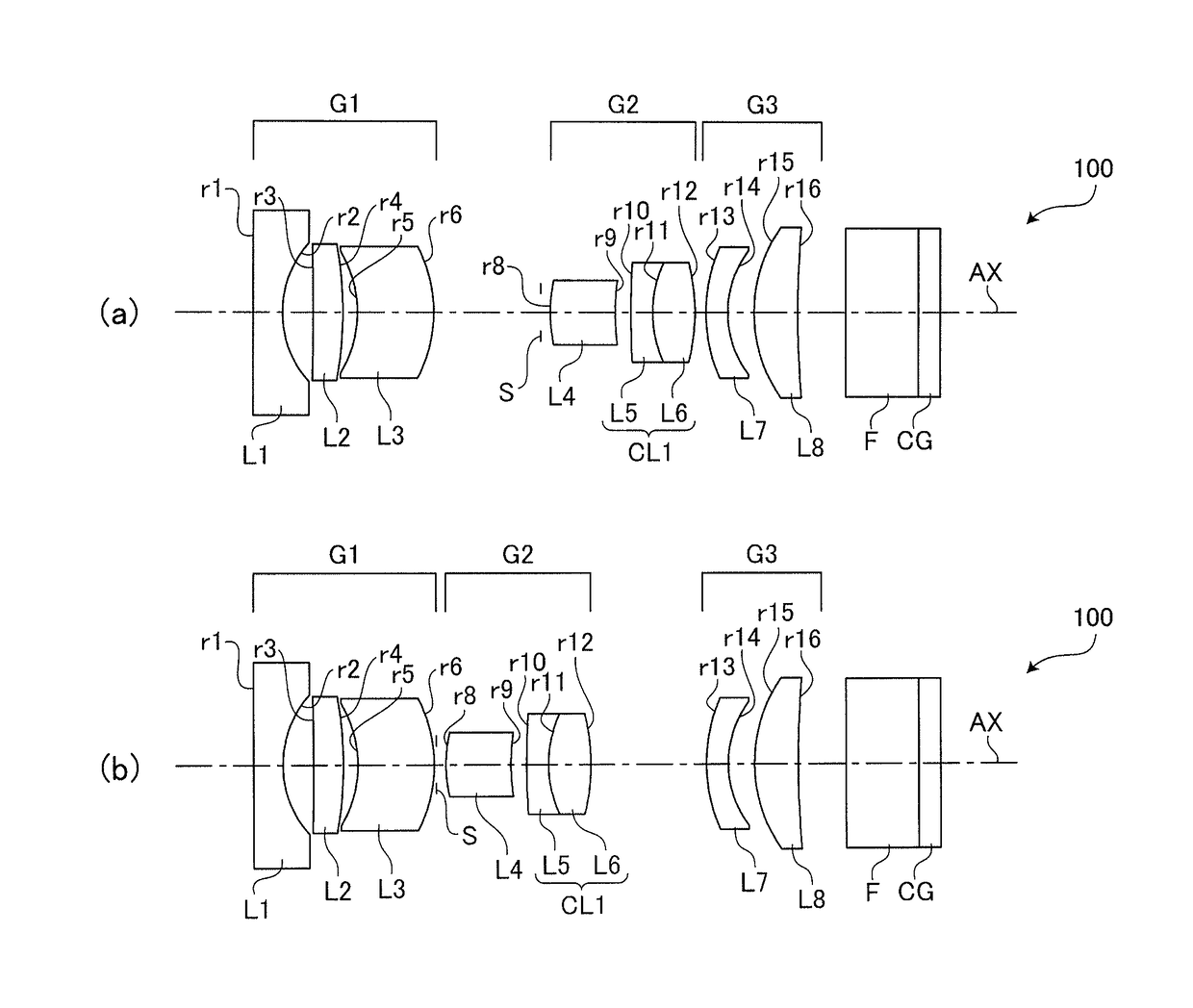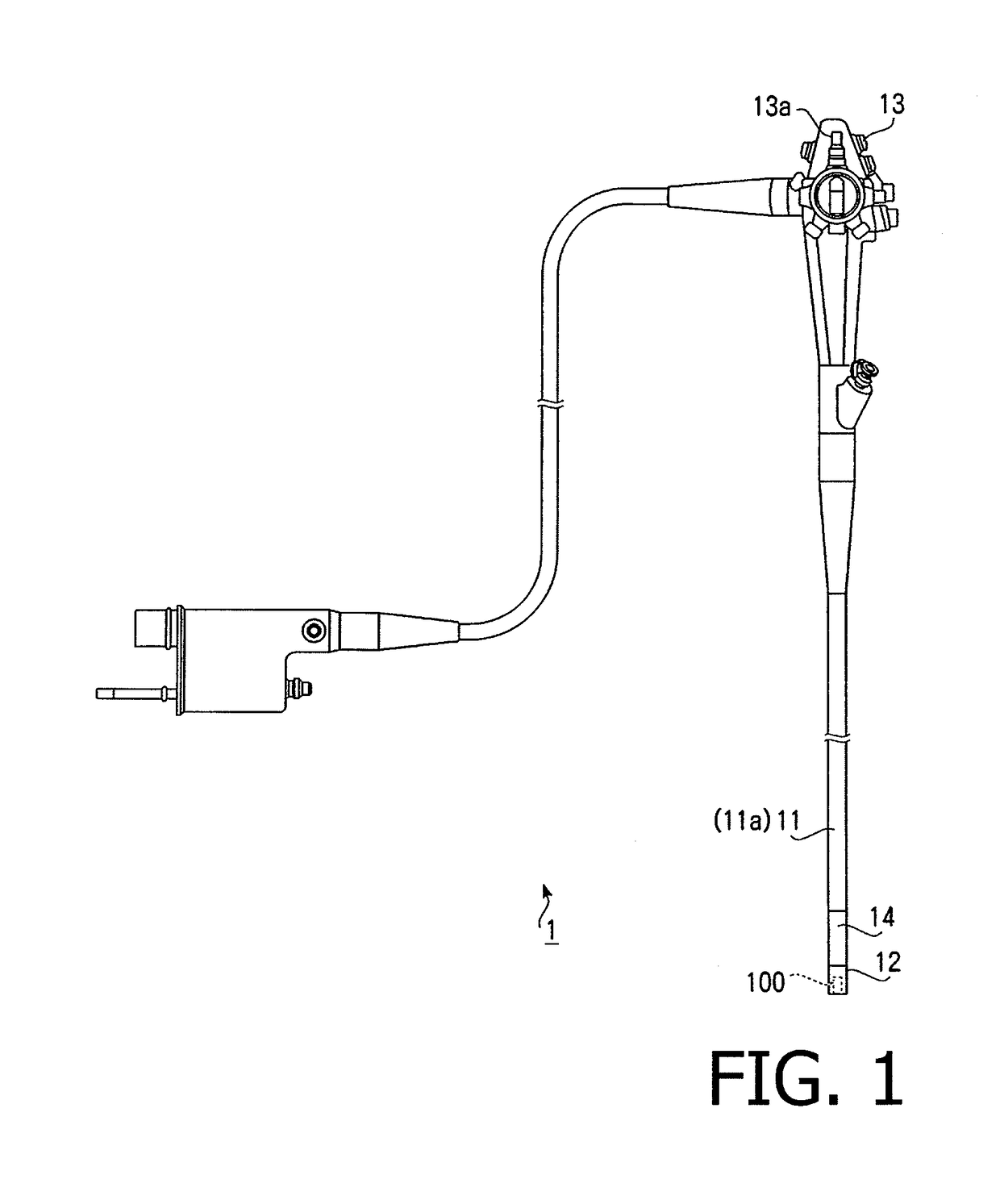Endoscope and variable power optical system for the same
a technology of variable power and endoscope, which is applied in the field of variable power optical system of endoscope and endoscope, can solve the problems of difficult installation in the fine tip portion of the endoscope, the effect of reducing the degree of freedom regarding disposing of components, and the effective diameter of the most object side negative lens needs to be increased, so as to achieve the effect of enabling the use of electronic scopes
- Summary
- Abstract
- Description
- Claims
- Application Information
AI Technical Summary
Benefits of technology
Problems solved by technology
Method used
Image
Examples
example 1
[0061]As described above, the variable power optical system 100 for an endoscope according to the example 1 has the configuration shown in FIG. 2.
[0062]Table 1 shows a concrete numerical configuration (design values) of the variable power optical system 100 for an endoscope (and the components disposed on the rear side thereof) according to the example 1. The surface number NO indicated in the top filed (surface data) in Table 1 corresponds to the surface reference rn (n: natural number) in FIG. 2, excepting the surface number 7 for the aperture stop S. In the top field of Table 1, R (unit: mm) denotes the radius of curvature of each surface of an optical component, D (unit: mm) denotes a thickness of an optical component or an interval between optical components on the optical axis, N(d) denotes a refractive index at d-line (wavelength of 588 nm), and νd denotes Abbe number at d-line.
[0063]The lower field (various data) of Table 1 shows, for each of the wide angle end and the telep...
example 2
[0067]Each of FIGS. 4(a) and 4(b) is a cross sectional view illustrating arrangement of optical components including the variable power optical system 100 for an endoscope according to the example 2. FIG. 4(a) illustrates the lens arrangement when the position of the variable power is at the wide angle end. FIG. 4(b) illustrates the lens arrangement when the position of the variable power is at the telephoto end.
[0068]Graphs A to D in FIG. 5(a) are aberration diagrams illustrating the various aberrations when the position of the variable power is at the wide angle end in the variable power optical system 100 for an endoscope according to the example 2. Graphs A to D in FIG. 5(b) are aberration diagrams illustrating the various aberrations when the position of the variable power is at the telephoto end in the variable power optical system 100 for an endoscope according to the example 2.
[0069]Table 2 shows a concrete numerical configuration and specifications of the optical components...
example 3
[0072]Each of FIGS. 6(a) and 6(b) is a cross sectional view illustrating arrangement of optical components including the variable power optical system 100 for an endoscope according to the example 3. FIG. 6(a) illustrates the lens arrangement when the position of the variable power is at the wide angle end. FIG. 6(b) illustrates the lens arrangement when the position of the variable power is at the telephoto end.
[0073]Graphs A to D in FIG. 7(a) are aberration diagrams illustrating the various aberrations when the position of the variable power is at the wide angle end in the variable power optical system 100 for an endoscope according to the example 3. Graphs A to D in FIG. 7(b) are aberration diagrams illustrating the various aberrations when the position of the variable power is at the telephoto end in the variable power optical system 100 for an endoscope according to the example 3.
[0074]Table 3 shows a concrete numerical configuration and specifications of the optical components...
PUM
 Login to View More
Login to View More Abstract
Description
Claims
Application Information
 Login to View More
Login to View More - R&D
- Intellectual Property
- Life Sciences
- Materials
- Tech Scout
- Unparalleled Data Quality
- Higher Quality Content
- 60% Fewer Hallucinations
Browse by: Latest US Patents, China's latest patents, Technical Efficacy Thesaurus, Application Domain, Technology Topic, Popular Technical Reports.
© 2025 PatSnap. All rights reserved.Legal|Privacy policy|Modern Slavery Act Transparency Statement|Sitemap|About US| Contact US: help@patsnap.com



